Total livestock inventory in the province reached 32,281 heads as of 1 January 2023. This figure posted an increase of 22.99 percent compared with the inventory of 26,247 heads during the same period of 2021. This can be attributed to the increase in the inventory of Goat and Hogs.
By animal type, Hogs accounted for the biggest share (50.03 percent) in the total livestock inventory of the province as of 1 January 2023. This was followed by Goat with 24.72 percent share, Carabao with 13.21 percent share, and Cattle with 12.04 percent share.
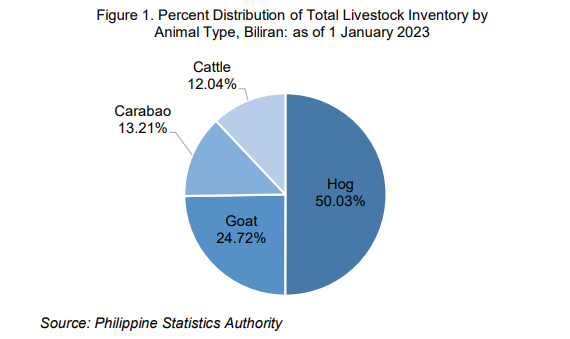
By farm type, there were more animals raised in backyard farms with 31,381 heads (97.21%) than in commercial farms with 900 heads (2.79%) as of 1 January 2023.
CARABAO SITUATIONER
As of 1 January 2023, inventory of carabao in the province totaled to 4,265 heads. By farm type, all 4,265 carabao heads as of 1 January 2023 were raised in backyard farms. There was no reported inventory of carabaos raised in commercial farms in both reference periods.
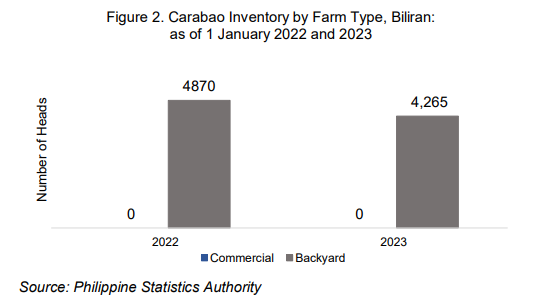
CATTLE SITUATIONER
Inventory of cattle in the province totaled to 3,886 heads as of 1 January 2023.
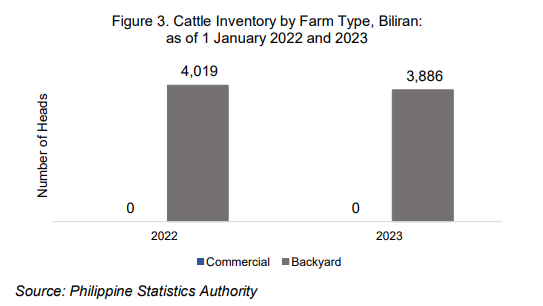
By farm type, all cattle as of 1 January 2023 were raised in backyard farms. There were no cattle raised in commercial farms as of 1 January 2023.
GOAT SITUATIONER
Provincial inventory of goats was recorded at 7,980 heads as of 1 January 2023 which is higher by 24.49 percent compared to 6,410 heads as of 1 January 2022. This can be traced to higher inventory of goats raised in backyard farms.
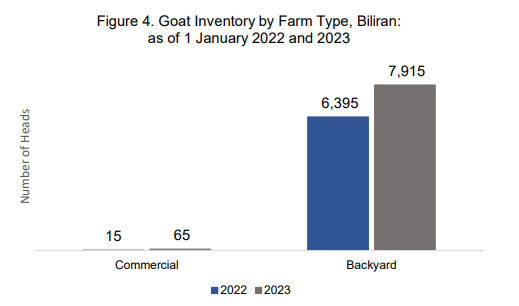
By farm type, majority (99.19 percent) of the total provincial goat inventory as of 1 January 2023 were from backyard farms with a total of 7,915 heads. Its inventory increased by 23.77 percent.
Meanwhile, goat in commercial farms comprised 0.81 percent. It reported an inventory of 65 heads, posting a 333.33 percent increase from its inventory of 15 heads as of 1 January 2023.
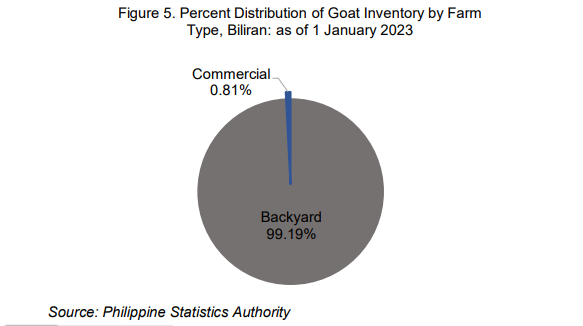
HOG SITUATIONER
The province recorded a total hog inventory of 16,150 heads as of 1 January 2023. This figure posted an increase of 47.52 percent from its inventory of 10,948 heads during the same period of 2022.
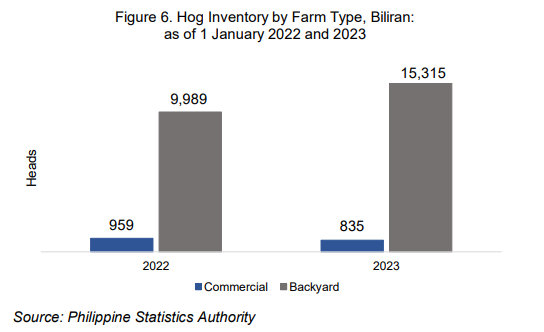
By farm type, hogs raised in backyard farms accounted for 94.83 percent of the total hog inventory in the province as of 1 January 2023. Moreover, its inventory was recorded at 15,315 heads which is higher by 53.32 percent than its inventory of 9,989 heads during the same period of 2022.
Hogs raised in commercial farms comprised the remaining 5.17 percent. It posted a decrease of 12.93 percent from 959 heads as of 1 January 2022.
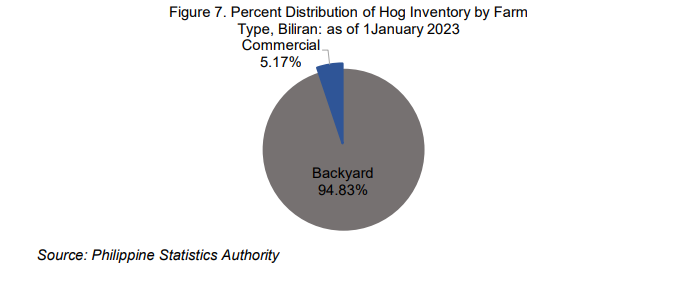
CHICKEN SITUATIONER
Total chicken population in the province stood at 108,689 birds as of 1 January 2023. This figure posted a decline of 35.99 percent from its inventory of 169,795 birds during the same period of 2022. This resulted from the decreased inventory of native chickens.
Inventory of native/improved chickens recorded a decline of 46.09 percent from 166,580 birds to 89,795 birds.
On the other hand, layers chicken posted an increase in its inventory as of 1 January 2023 by 1,628.64 percent from 1,093 birds to 18,894 birds. Broiler chickens recorded an inventory of 2,122 birds as of 1 January 2022 but had no reported inventory as of 1 January 2023.
By type, native/improved chicken comprised the majority (82.62%) of the total provincial chicken population as of 1 January 2023. Meanwhile, layer chicken shared 17.38 of the total inventory.
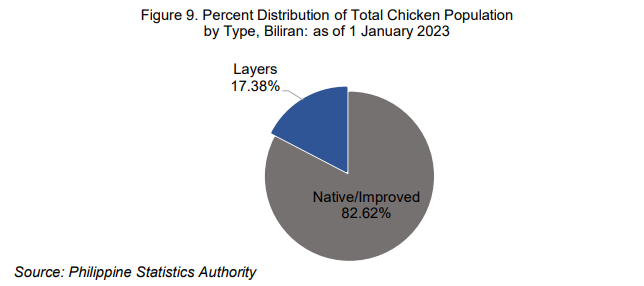
DUCK SITUATIONER
A total of 9,786 birds were noted in the inventory of ducks as of 1 January 2023. This posted an increase of 116.94 percent from 4,511 birds during the same period of 2022.
By farm type, all ducks as of 1 January 2023 were raised in backyard farms. There were no ducks raised in commercial farms in both reference periods.
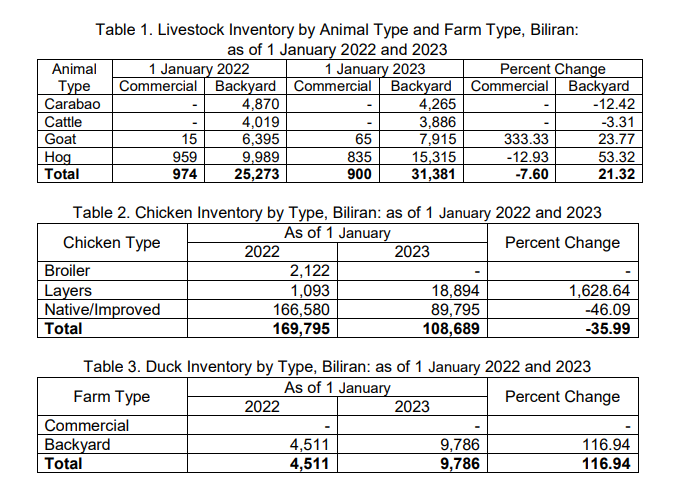
EXPLANATORY NOTES
The data for this special release were collected by the Philippine Statistics Authority (PSA) through two (2) major surveys, namely Backyard Livestock and Poultry Survey (BLPS) and Commercial Livestock and Poultry Survey (CLPS).
These two surveys are undertaken every quarter. Both surveys will determine and measure the inventory, disposition, and volume of production of farm animals from the backyard and commercial livestock and poultry industry in the country.
Another survey that supplements the data requirements of the Livestock and Poultry sector is the Compilation of Data on Slaughterhouses and Poultry Dressing Plants. This survey is done monthly and utilizes administrative data from accredited slaughterhouses and poultry dressing plants including the Locally Registered Meat Establishments (LRMEs).
SGD. RENAVIL V. CUEVA
Chief Statistical Specialist

